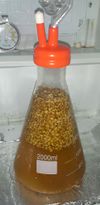Just picked up a couple vials of Sacch. Trois from White Labs. I'm thinking a 1.050 blonde wort w/ some wheat. boil, chill, sour with Lacto for a few days, return to Kettle and bring to 180F. Add 3 0z. of Amarillo and hold for a 30 min.hop-stand. Chill, ferment to completion with the Trois. Dry hop in the keg with .5 oz. Amarillo and 1 oz. Galaxy. Should be tasty!

Dry-hopped Sour
#1

Posted 30 September 2017 - 02:18 PM
#2

Posted 30 September 2017 - 04:04 PM
#3

Posted 30 September 2017 - 04:47 PM
#4

Posted 30 September 2017 - 05:01 PM
Look into using yogurt or good belly for a souring source. Local brewery does some nice kettle soured dryhopped sours.
I've been having great success with grain starters.
#5

Posted 30 September 2017 - 05:15 PM
If the brewer wants to use the LAB found naturally on the husks of grains, and doesn't want to risk pitching grains into the entire batch of wort, a starter culture can be made. The benefit of this is that if the culture contains any vomit, fecal, or putrid aromas, it can be thrown away and tried again. If the starter needs to be dumped, try again with a different malt source; microbial populations can vary greatly between maltsters, harvest years, and malt type [7]. The following is Derek Springer's grain starter process [8]:
- In a 2L flask make a standard starter wort (1.040 OG).
- Add 1/2 tsp 88% lactic acid (should get pH down to 4.0 - 4.5 to help inhibit off-flavor producing microbes).
- Add 2 cups uncrushed malt (using acidulated malt is not required).
- Top off with carbonated water.
- Cap with an airlock.
- Keep as warm as you can for 2-3 days, ~110°F is best.
- After 2-3 days, strain the grains out using a colander. If no off aromas are detected, pitch the entire starter into the wort using one of the methods described on the Sour Worting page.
If the starter is not going to be used right away, storing it in the fridge for up to a couple of weeks should be fine. If the starter still smells sweet/vegital then it should be ok to use. However if the starter starts to produce aromas of feces or vomit, do not use it [9]. It is probably not always safe to consume any of the grain starter until after it has become beer (see Wild Yeast Starters and Safety).
#6

Posted 30 September 2017 - 05:39 PM
#7

Posted 30 September 2017 - 07:16 PM
0 user(s) are reading this topic
0 members, 0 guests, 0 anonymous users










